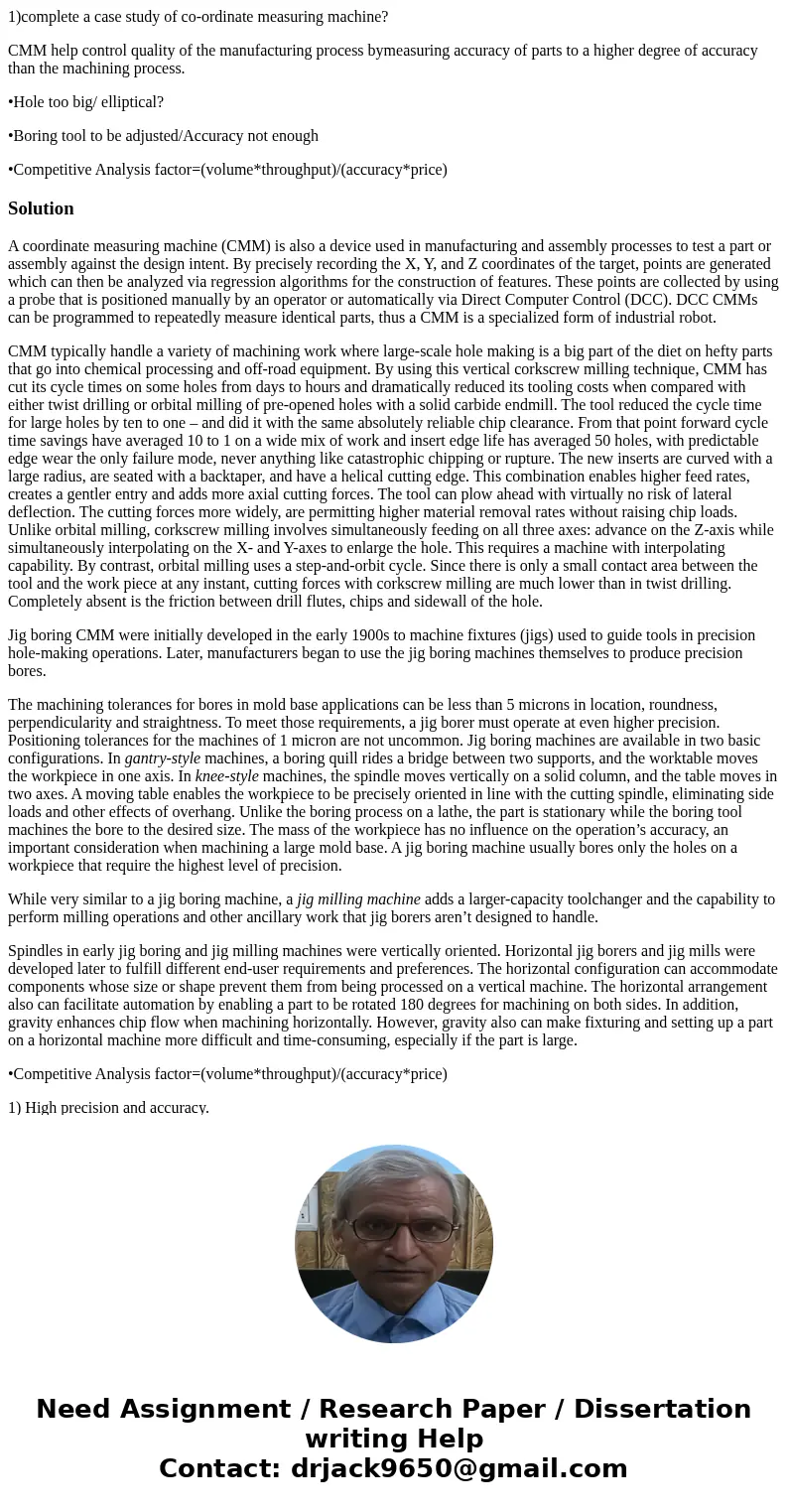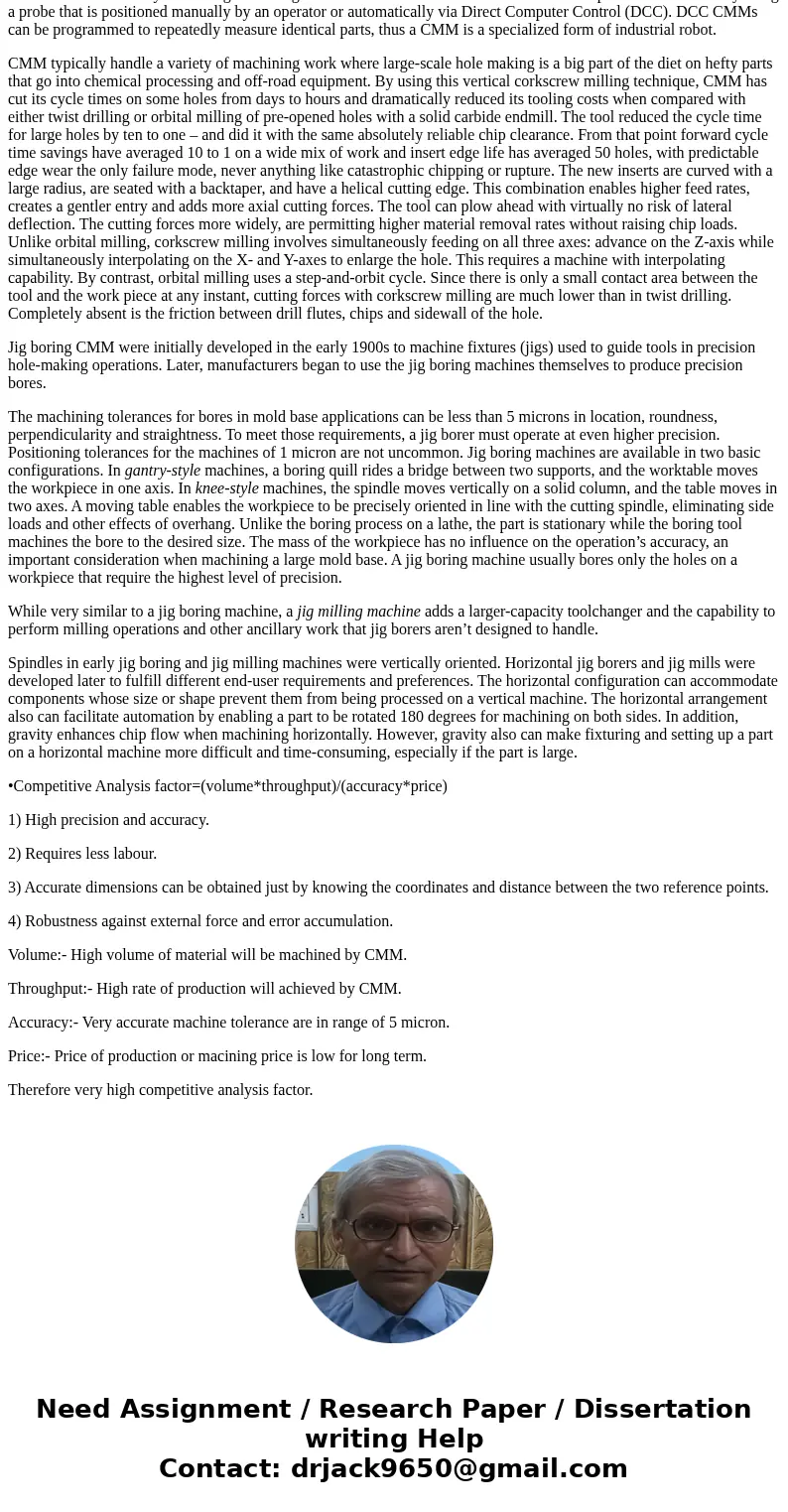1complete a case study of coordinate measuring machine CMM h
1)complete a case study of co-ordinate measuring machine?
CMM help control quality of the manufacturing process bymeasuring accuracy of parts to a higher degree of accuracy than the machining process.
•Hole too big/ elliptical?
•Boring tool to be adjusted/Accuracy not enough
•Competitive Analysis factor=(volume*throughput)/(accuracy*price)
Solution
A coordinate measuring machine (CMM) is also a device used in manufacturing and assembly processes to test a part or assembly against the design intent. By precisely recording the X, Y, and Z coordinates of the target, points are generated which can then be analyzed via regression algorithms for the construction of features. These points are collected by using a probe that is positioned manually by an operator or automatically via Direct Computer Control (DCC). DCC CMMs can be programmed to repeatedly measure identical parts, thus a CMM is a specialized form of industrial robot.
CMM typically handle a variety of machining work where large-scale hole making is a big part of the diet on hefty parts that go into chemical processing and off-road equipment. By using this vertical corkscrew milling technique, CMM has cut its cycle times on some holes from days to hours and dramatically reduced its tooling costs when compared with either twist drilling or orbital milling of pre-opened holes with a solid carbide endmill. The tool reduced the cycle time for large holes by ten to one – and did it with the same absolutely reliable chip clearance. From that point forward cycle time savings have averaged 10 to 1 on a wide mix of work and insert edge life has averaged 50 holes, with predictable edge wear the only failure mode, never anything like catastrophic chipping or rupture. The new inserts are curved with a large radius, are seated with a backtaper, and have a helical cutting edge. This combination enables higher feed rates, creates a gentler entry and adds more axial cutting forces. The tool can plow ahead with virtually no risk of lateral deflection. The cutting forces more widely, are permitting higher material removal rates without raising chip loads. Unlike orbital milling, corkscrew milling involves simultaneously feeding on all three axes: advance on the Z-axis while simultaneously interpolating on the X- and Y-axes to enlarge the hole. This requires a machine with interpolating capability. By contrast, orbital milling uses a step-and-orbit cycle. Since there is only a small contact area between the tool and the work piece at any instant, cutting forces with corkscrew milling are much lower than in twist drilling. Completely absent is the friction between drill flutes, chips and sidewall of the hole.
Jig boring CMM were initially developed in the early 1900s to machine fixtures (jigs) used to guide tools in precision hole-making operations. Later, manufacturers began to use the jig boring machines themselves to produce precision bores.
The machining tolerances for bores in mold base applications can be less than 5 microns in location, roundness, perpendicularity and straightness. To meet those requirements, a jig borer must operate at even higher precision. Positioning tolerances for the machines of 1 micron are not uncommon. Jig boring machines are available in two basic configurations. In gantry-style machines, a boring quill rides a bridge between two supports, and the worktable moves the workpiece in one axis. In knee-style machines, the spindle moves vertically on a solid column, and the table moves in two axes. A moving table enables the workpiece to be precisely oriented in line with the cutting spindle, eliminating side loads and other effects of overhang. Unlike the boring process on a lathe, the part is stationary while the boring tool machines the bore to the desired size. The mass of the workpiece has no influence on the operation’s accuracy, an important consideration when machining a large mold base. A jig boring machine usually bores only the holes on a workpiece that require the highest level of precision.
While very similar to a jig boring machine, a jig milling machine adds a larger-capacity toolchanger and the capability to perform milling operations and other ancillary work that jig borers aren’t designed to handle.
Spindles in early jig boring and jig milling machines were vertically oriented. Horizontal jig borers and jig mills were developed later to fulfill different end-user requirements and preferences. The horizontal configuration can accommodate components whose size or shape prevent them from being processed on a vertical machine. The horizontal arrangement also can facilitate automation by enabling a part to be rotated 180 degrees for machining on both sides. In addition, gravity enhances chip flow when machining horizontally. However, gravity also can make fixturing and setting up a part on a horizontal machine more difficult and time-consuming, especially if the part is large.
•Competitive Analysis factor=(volume*throughput)/(accuracy*price)
1) High precision and accuracy.
2) Requires less labour.
3) Accurate dimensions can be obtained just by knowing the coordinates and distance between the two reference points.
4) Robustness against external force and error accumulation.
Volume:- High volume of material will be machined by CMM.
Throughput:- High rate of production will achieved by CMM.
Accuracy:- Very accurate machine tolerance are in range of 5 micron.
Price:- Price of production or macining price is low for long term.
Therefore very high competitive analysis factor.


 Homework Sourse
Homework Sourse